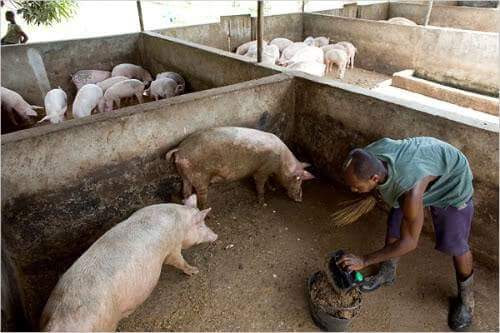Routine husbandry practices when raising pigs

Routine husbandry practices for raising pigs include:
Feeding pigs
Feed all animals twice a day with a restricted amount of dry concentrates and free access to fresh water. Restricted access is used for the following reasons:
- It gives maximal feed conversion efficiency (FCE). FCE is the most important factor in the economy of feeding of pigs as the cost of feeds account for about 70% of the total costs in pig production.
- Restricted feeding gives animals meat quality. The most important factors in grading of pigs meat in Kenya are carcass weight, back-fat thickness and age. A too high level of feeding will produce a carcass with too much fat and subsequent low grading.
- Recording of feed consumption makes it possible to calculate FCE for various groups.
Alternative feeding systems are adlib and semi adlib feeding.
The feeding standards used are available at the National Research Council and Kenya Bureau of Standards.
Feed mixtures
Feeds for pigs must be energy rich, low in crude fibres and contain all nutrients required by pigs. Various age groups have different nutrient requirements. Commercial feed mixtures commonly used are.
- Sow and weaner meal is used for all breeding animals and growing pigs from weaning to about 50kg liveweight.
- Pig finishing meal is used for finishing pigs from 50kg liveweight to marketing.
- Creep pellets are used from 2 weeks to weaning.
Other available commercial feed mixtures for pigs are cereal balancers used to mix with home grown cereals, and skim balancer used together with skim milk.
Home made mixtures
No simple feedstuffs contain all nutrients pigs need in the correct proportion. A feed mixture will principally be composed of
- Energy rich feeds (cereals)
- Protein feeds (plant or animal origin)
- Mineral feeds (salts)
- Vitamin premix
Cleaning
Routine daily cleaning – Remove the manure from all pens twice per day.
Clean empty pens to reduce transfer of diseases. Thoroughly and mechanically clean by scrubbing with water and brush all pens which are emptied when either the pigs are sent to slaughter or transferred to other pens.
Prepare farrowing pens because newborns are more susceptible to all diseases than older pigs. One of the most important steps in reduction of mortality in pigs is to provide the newborn pigs with an optimal environment. About one week before the expected time for farrowing the sow is brought into the farrowing pen. Before this clean and disinfect the pen and wash the sow then treat for external and internal parasites. Equip the creep area when farrowing is expected to ensure an environment with optimal temperature and humidity free from draught.
Weighing
Suckling pigs
The weight at birth, 2,3,4,6 and 8 weeks indicate milk production in the sow and mothering abilities.
Growing pigs
Weigh growing pigs once per fortnight and when approaching market weight once per week. This is useful for
- Allocation of amounts of feeds
- Calculation of growth rate and FCE
- Checking performance
- Estimate the most economic time for slaughter.
Method for estimation of liveweight
Suckling pigs can easily be weighed by an ordinary scale. Older pigs (20 kg upwards), however, can only be weighed in special scale designed for weighing animals. Heavier animals are cumbersome to handle.
The liveweights can roughly be estimated from the heart girth. The weight can then either be estimated directly from the weigh band or from tables. Such tables vary according to type of pigs, breeds and level of feeding.
Castration
Castrate all male pigs to avoid the “Boar taste” which develops in boars approaching sexual maturity. Castration is easily done at 3 weeks of age. Avoid castration of sick pigs and check for malformations such as cryptochidism, hernia and intersex.
Parasite control
Spray against external parasites such as lice and mange. Spray sows once or twice leaving a three weeks interval. Then spray the last time one week before farrowing.
Piglets at weaning
Spray growing pigs and boars when necessary. Don’t spray during the last week before slaughter.
Deworming should be done at the same time as spraying.
Identification
Although ear tattooing is cheap and can be used on new born, it can be difficult on older pigs. Ear notching is also cheap but one must know the system to be able to interpret the numbers. Notched ears can be damaged during fighting or ear biting and cannot be used on new born. Ear tags are easy to read but expensive and can be lost.
Practically all newborn pigs are tattooed and ear notched at weaning. Breeding animals are ear tagged
Selection of breeding animals
Factors to consider when selecting breeding animals ranked according to importance.
- Feed conversion efficiency
- Backfat thickness (lean to fat ratio)
- Fertility, litter size
- Growth rate
- Conformation
- Type
- Body length
- Weight gain in piglets
Heat detection and mating
Gilts have their first heat at 5 – 6 months age. They should not be served before 8 months and 100 kg liveweight.
Sows come on heat 2 – 5 days after weaning, depending on length of suckling period
The length of heat is between 40 – 43 hours and ovulation takes place in the beginning of the half of the estrus period.
Signs of heat include swelling and reddening of vulva and discharge of mucous, changed behavior, restless, loss of appetite, and riding on others.
Gestation period takes 113 to 115 days.
Record keeping
Keep the following records:
Breeding animals
- Service record
- Litter size (dead, living)
- Liveweight of piglets
Baconers
- Liveweight
- Feed consumption
- Grading



